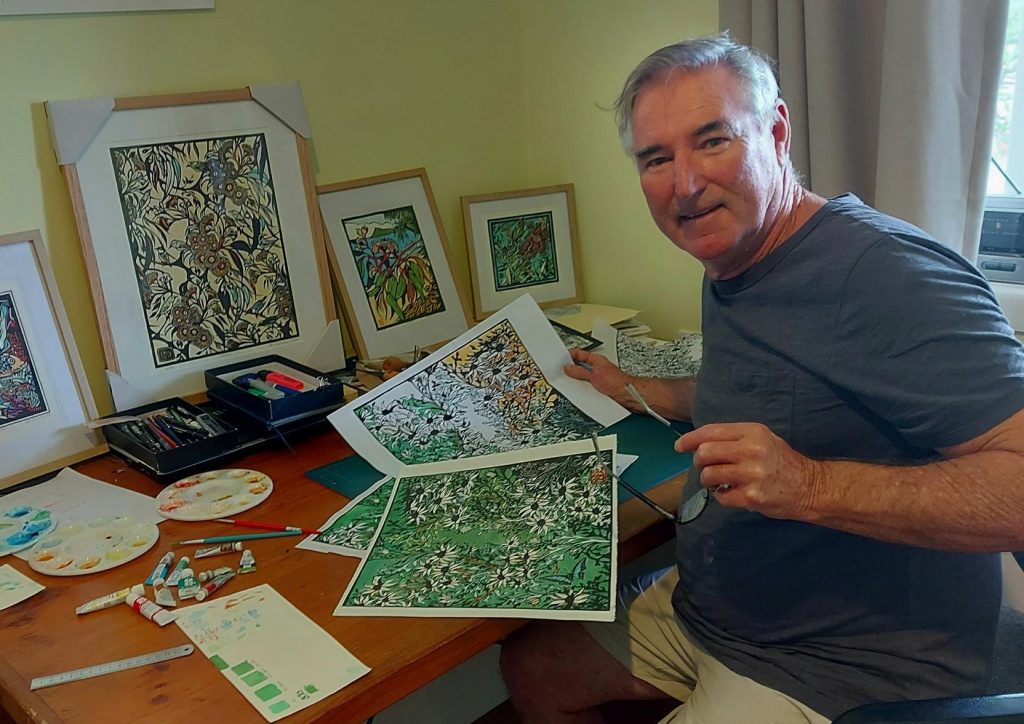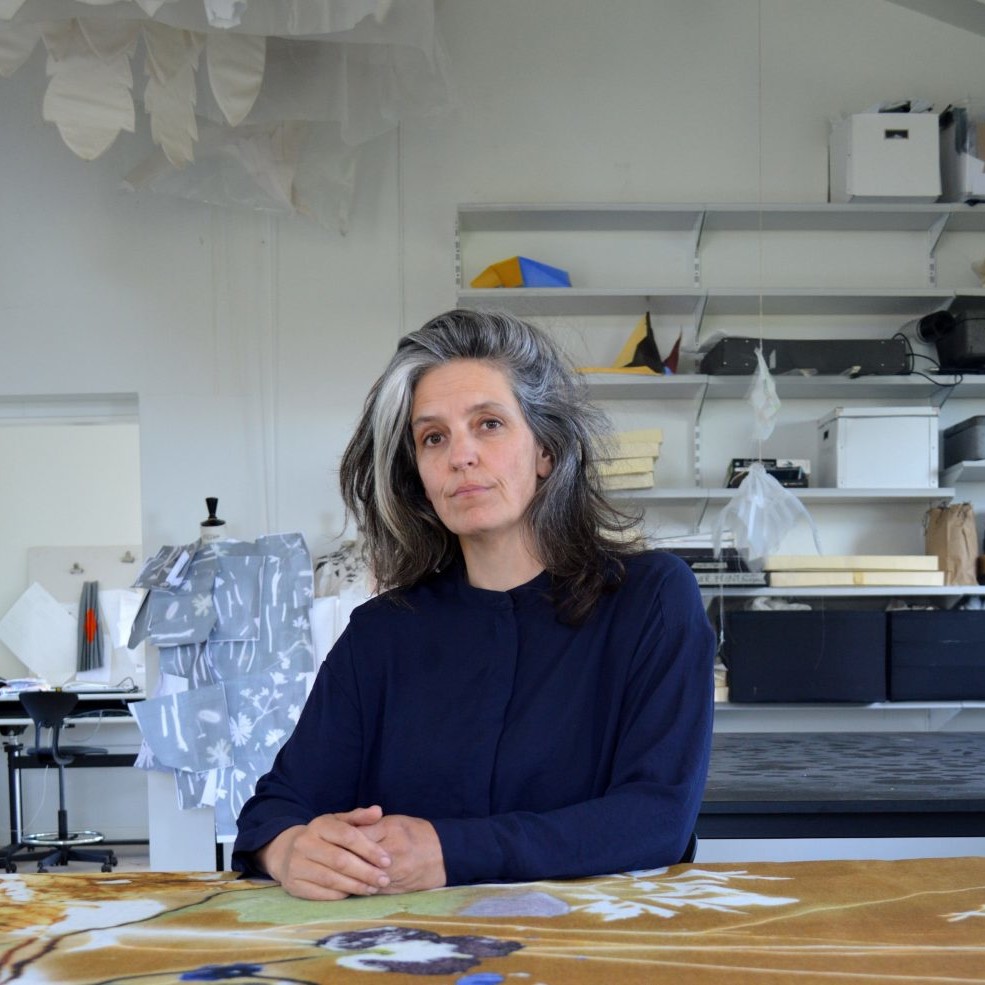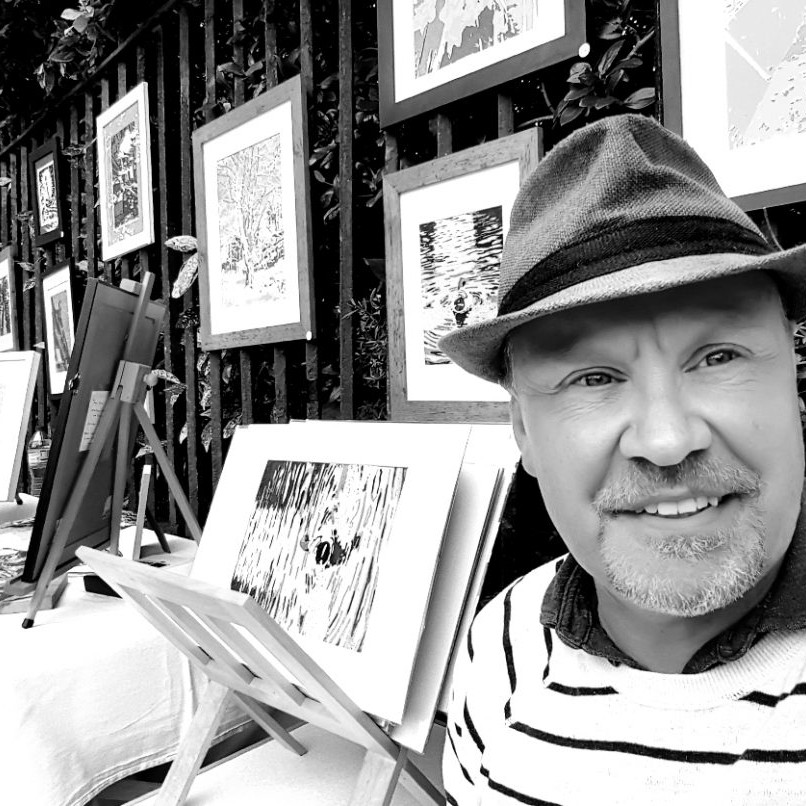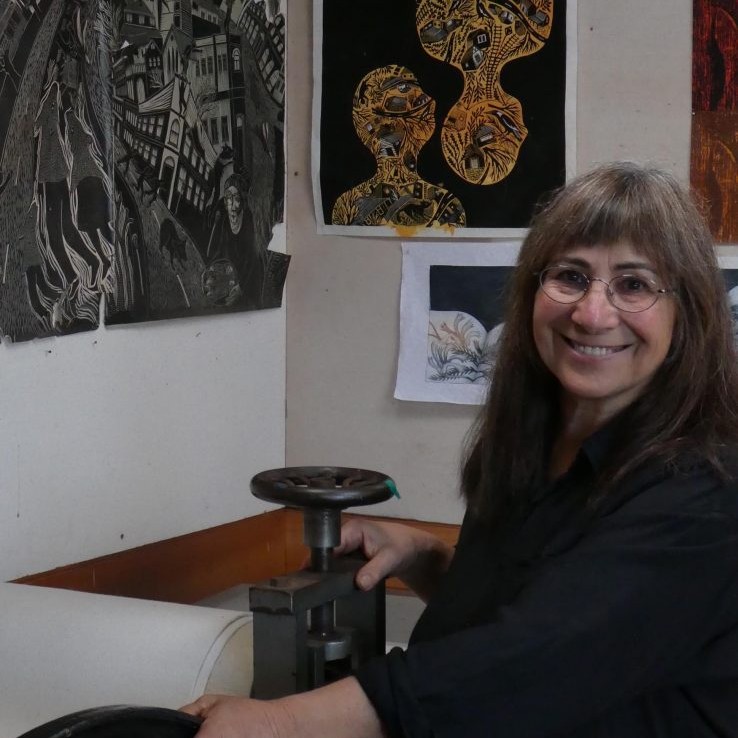Brian Davidson Printmaker
Can you explain the difference between printmaking and watercolourist prints?
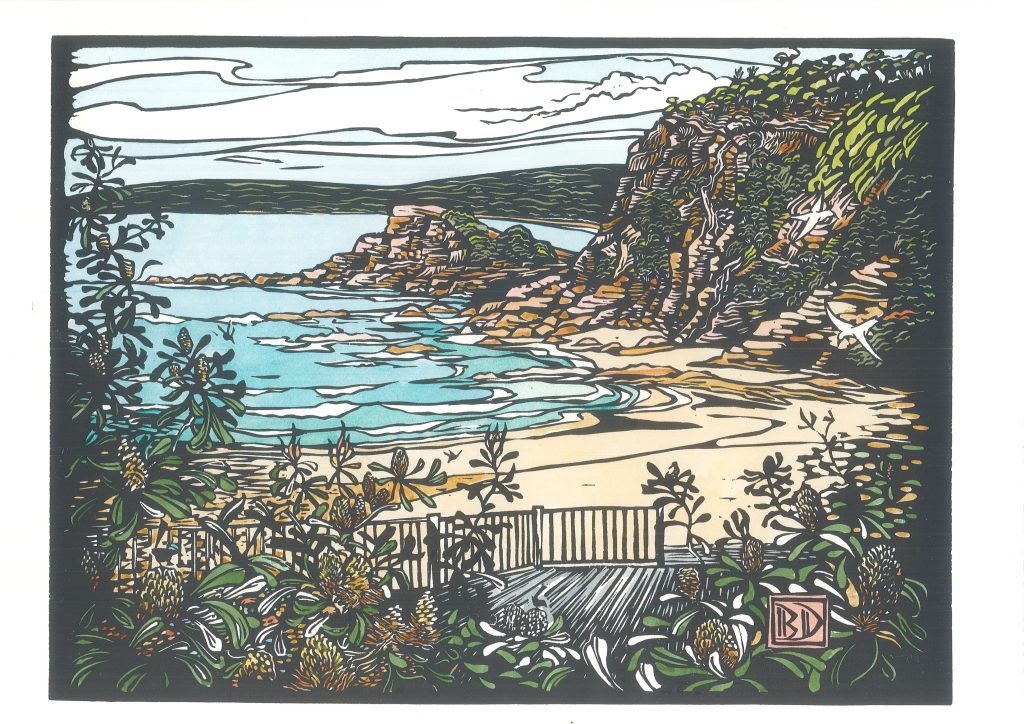
Pambula Beach
Unlike reduction Lino Printing where the lino (or other substrata) is successively cut and printed in layers using a different colour each impression and building up the image, a hand coloured Lino Print is printed once, usually using black ink.
In my work I like to focus on the linework of the print. I am ever conscious of the quality of the line as I am cutting. Of course, patterning can be done but I particularly like and rely on the strength of the line.
What is left behind is the area that will accept the ink and be the printed part, it is like working in reverse. One of the joys of printmaking is that the result of the labours are not seen until making that first impression so there is a surprise element involved.
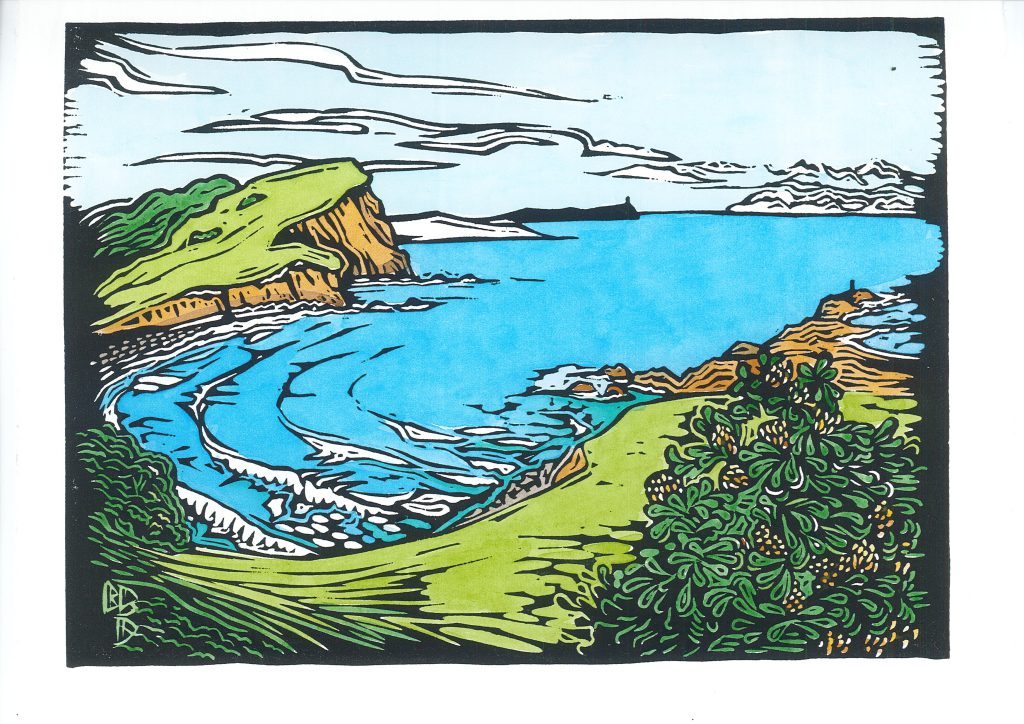
The Peg
Take us through the process of photography / sketching and hand colouring.
When working on outdoor scenery, for me usually coastal, I like to sketch in-situ and use photographs as reference later in the studio.
Sketching and thumbnails have the advantage of moving the elements of the composition, diminishing areas, highlighting others or even moving elements so they fit the balance of the design.

Grafton Sculler linocut
I see sketching as important as it brings an organic feel to the design which follows right through the entire process, even though the printmaking process is a mechanical one.
At times the image I am trying to create pops up with the least amount of effort almost complete with everything in place and colour solutions, but there is also occasions when the process is slow and meticulous with many iterations of the theme, sometimes taking months.
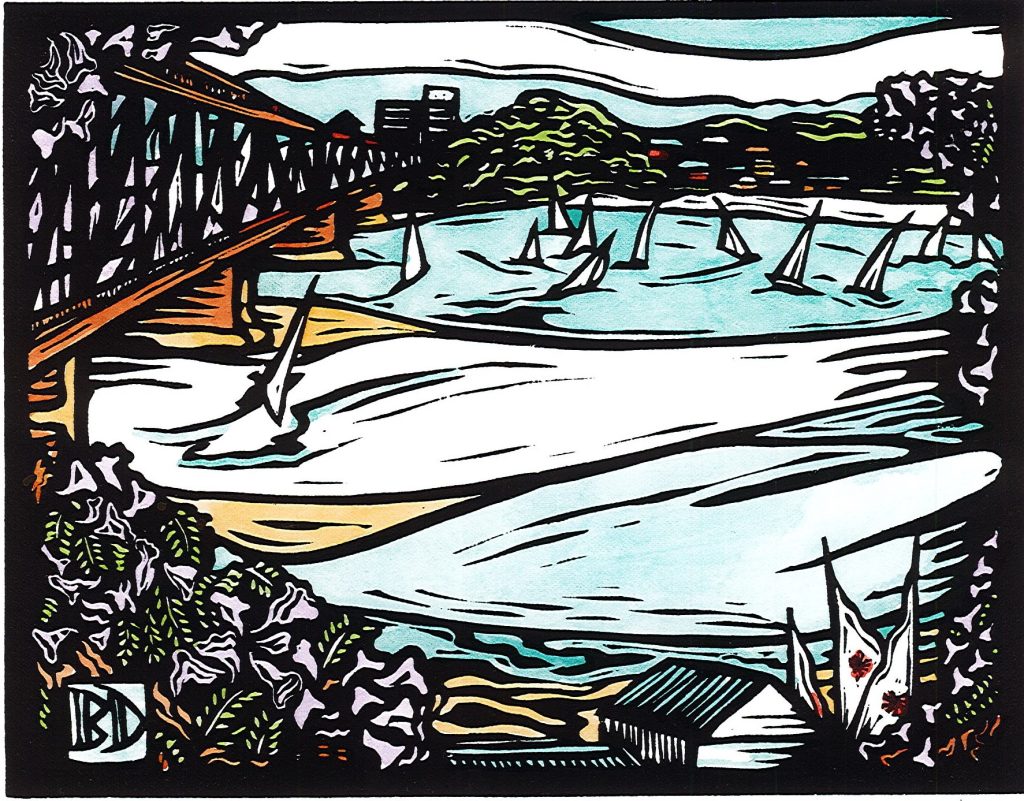 Sunday Sail
Sunday Sail
I begin by transferring the design to the lino (remembering to mirror the image; I produced a headland print once and forgot to do this, and even printed it before I saw my blunder!), now the cutting begins using regular lino/woodcutting tools I have also fashioned and modified tools and blades.
The cutting process, even for a simple design, takes me at least three days and often stretching up to 8 or 10 days, though not working continuously, after printing the oil based inks will take a few days to dry before any colour can be applied. Typically, I print onto 300gsm watercolour paper and colour using Artist quality watercolours.
It is usual that the first printing impression will reveal the need for further cutting and finessing and some colour experimentation before the edition is made, these first one or two prints are classed as Artist Proof prints, and though they substantially resemble the editioned prints they really are unique in themselves, some print collectors seek out A/P’s.
My editions typically run from 20 to 50. When the edition has been completed the block is destroyed, thus keeping the integrity of the ‘limited’ edition.
Are all, of your works of nature?
Nature certainly provides the main source for my work. In my training and education in illustration the focus was to observe and record, sometimes even at scientific level.
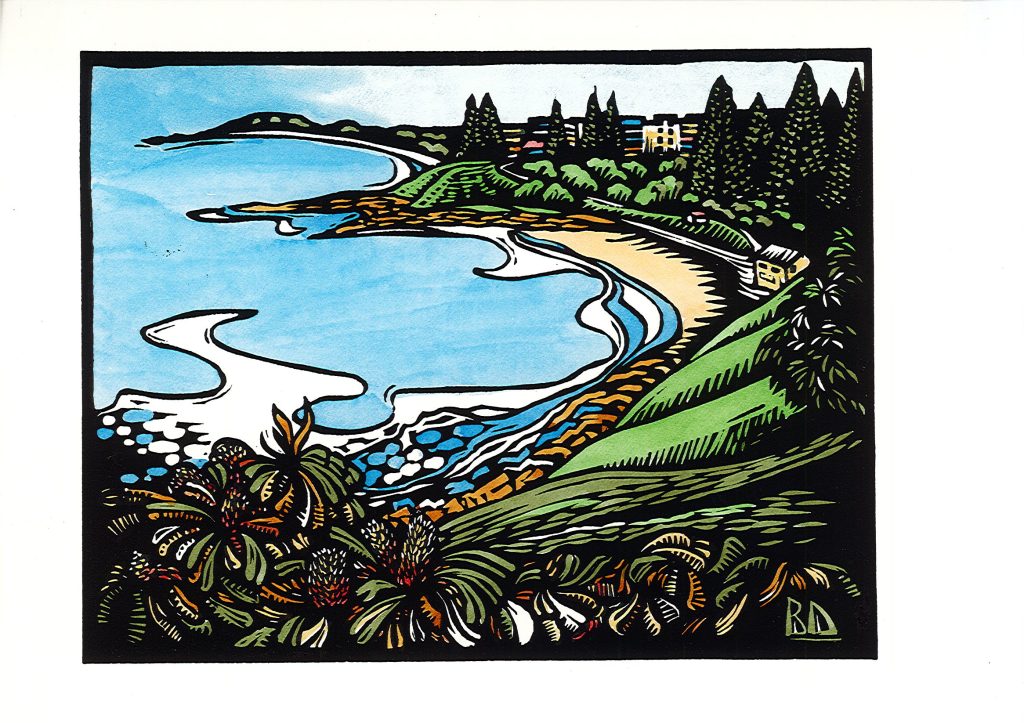 Yamba Main Beach linocut
Yamba Main Beach linocut
How has living in the North Coast of NSW, Australia influenced your work?
I have always lived on the coast so the littoral and coastal environment is an easy palette to draw material from.
The coastal zone is a contained area, stretching from the tidal mark to behind the sand dunes, this being not more than some tens of metres, but even so I never tire of the flora and fauna that survive and thrive in this weather lashed zone, the diversity is really amazing for quite a restricted and small area. It’s my go-to subject.
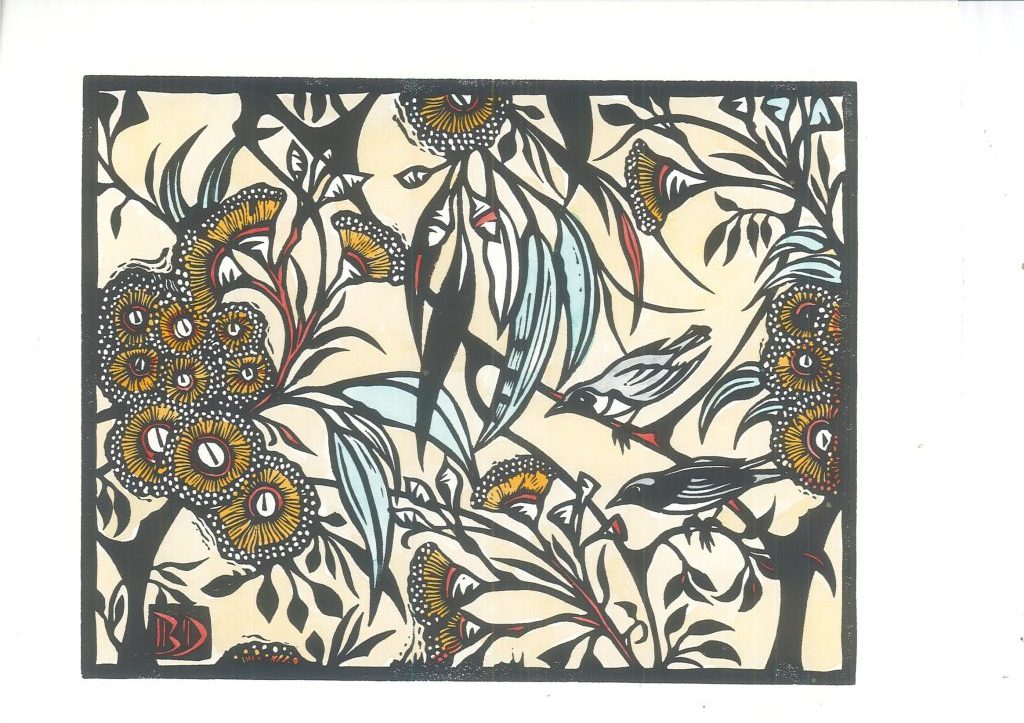
Thornbills
Do you have your own press, or do you work in a print studio?
One of the attractions of printmaking for me is that it is a process, and, in making a print you move through these processes in an ordered and organised way.
I have connections with printing studios and groups though I like to use them only for mundane tasks and social interaction with other artists. I find it much more productive working from my home studio, even using a hand press and finishing with a berrens, which can be quite physical, the result is infinitely less mistakes, less wastage and work gets produced.
Printmakers are big talkers!
Discuss the importance of the border of a good quality print.
Hand coloured Lino prints, due to their nature seem to be invariably framed by a border, the border substantiating the heavy graphic quality of the print.
Early on I began ascribing a non-descript 4mm border on my prints which is quite traditional, but I now also like to vary the width so it might become nothing more than a thin edging or add some design embellishment within the border.
Discuss Australian flowers you keep returning to and why?
Now, after some years creating Lino prints I find I don’t need to draw too much detail of any particular object but rather prefer to concentrate on the shape and elements in my mind’s eye.
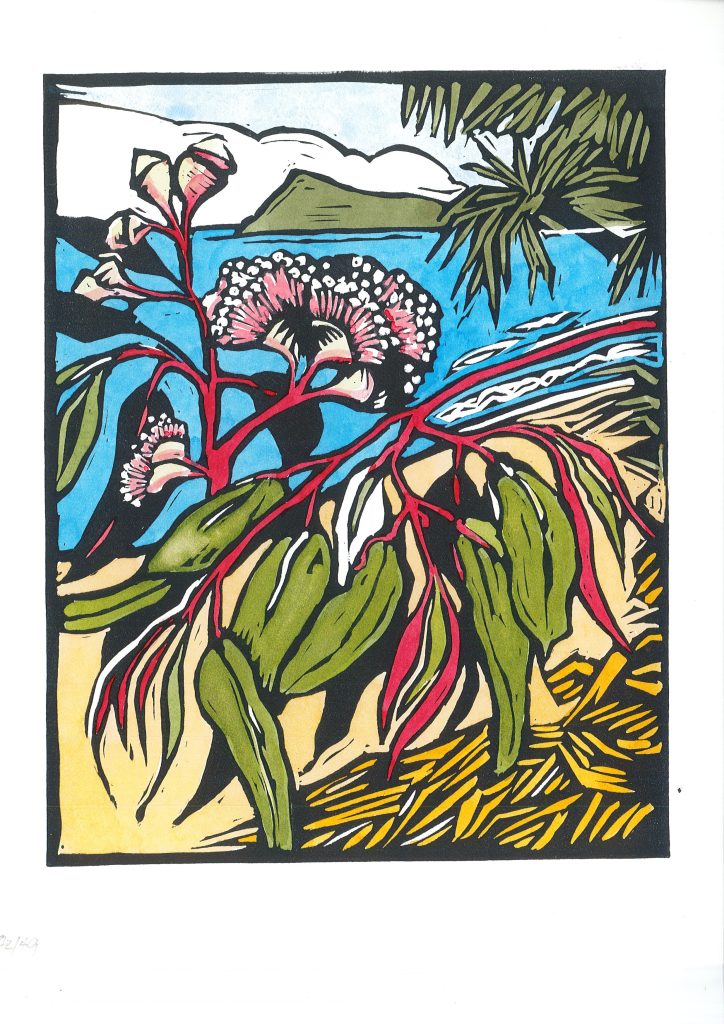 Lennox Eucalyptus
Lennox Eucalyptus
When cutting, say a banksia, I find I can work intuitively with my focus on the design aspect of that flower. I work quite quickly when doing this, not thinking too much but allowing the tools to take over the task. Submersing oneself in the subject I suppose.
Flowers are a great challenge to represent, it’s easy to get them wrong. I would love to do an extended tour making Lino prints of Australian wildflowers.
I pursue underwater subjects too but they are much harder to problem solve.
Do you have any endangered birds or plants that are on the endangered list in your work?
I enjoy taking up causes to do with the environment and conservation.
One such program is called ‘The Overwintering Project’, which can be found on the Net. This specifically relates to printmakers and printmaking in all its forms and investigates, documents and illustrates the plight of migratory birds from the northern hemisphere travelling so many thousands of kilometres to Australia’s wetlands where they stay through the northern winter. – ‘After all, we have the spare parts and we’ve got a voice’
 Terns
Terns
I think, as an artist, we are in a prime position to take an altruistic approach to causes like this and add another shoulder to the wheel, after we have the spare parts and we’ve got the voice.
Discuss the almost pattern in some of your work?
This is a revealing question on my approach to making my art.
On occasions someone, when viewing my work will blurt out “Margaret Preston!”, which I sort-of-get but I have never paid her work much attention at all. BUT had they said “William Morris” then they would have covered many bases.
I am spurred on by the repetition in nature, the seeming chaos of the design in nature, the accidentalness in nature which when all put together represent the ‘order’ in nature.
 Honeyeaters
Honeyeaters
I am glad Deborah you note the almost pattern in some work. When making a design which features a repeating design, I make a much bigger drawing which will include a complete repeating design, but, when I make the final design however, I will delete parts of the design, add some elements in and in doing so disguising the repeat.
Did that almost answer the question?
I believe in the functionality of Art, e.g. I love the Silo projects – would love to do one!
I have adapted some of my repeat designs for printing onto lengths of fabric too for personal use.
Are all your prints framed, and unframed for sale?
I do sell prints unframed but galleries prefer framed work.
I have now standardised my artwork into 3 sizes (traditional Japanese prints were produced in standard sizes because of the blocks used for carving). For a printmaker this makes sense when producing a number of same sized prints needing the same sized frame.
So now, I have a number of blank frames with matts & glass etc made up and keep in stock. When needed I can assemble on demand.
Comment on your Wooli River work?
The Wooli print, about A4 size, is the outcome of a small community, on the north coast of NSW, taking the conservation of their local habitat into their own hands by holding an Art Exhibition each year. The exhibition acts as a fundraiser to restore dunes of the beach and Wooli River, a lot of work by a small group of individuals.
I am very glad you have asked me to discuss this print Deborah as it is also a good example of how I settle on the content of my work.
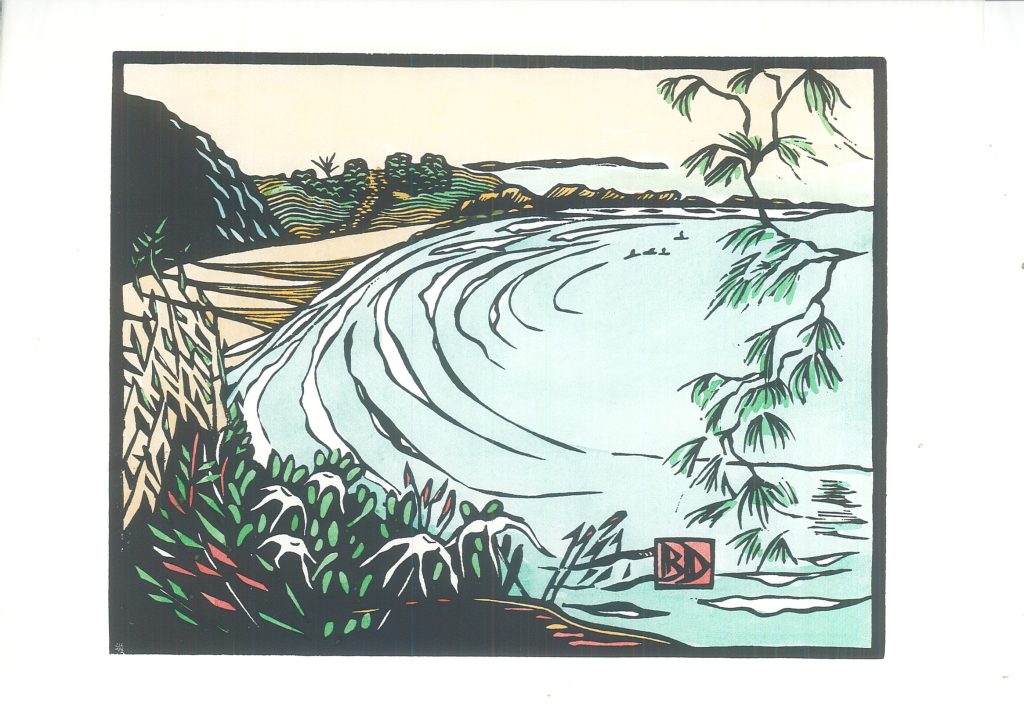 Minni Water
Minni Water
No matter how alluring and ready made a scene might appear, I find myself rejecting first impressions and obvious standout elements for a much longer investigation, opting for walking, exploring, leaving the locality and then returning, sometimes time and time again.
Eventually something, a small area, a view from a particular point, the colours at a particular moment will throw a new perspective on the scene and define an essence of the locality, a timeless instant (if that exists) which is older and deeper than the big picture crowding your view.
This is a slow process and cannot be rushed
I find if I get these small details in focus then the big stuff falls over itself just trying to get into the picture!
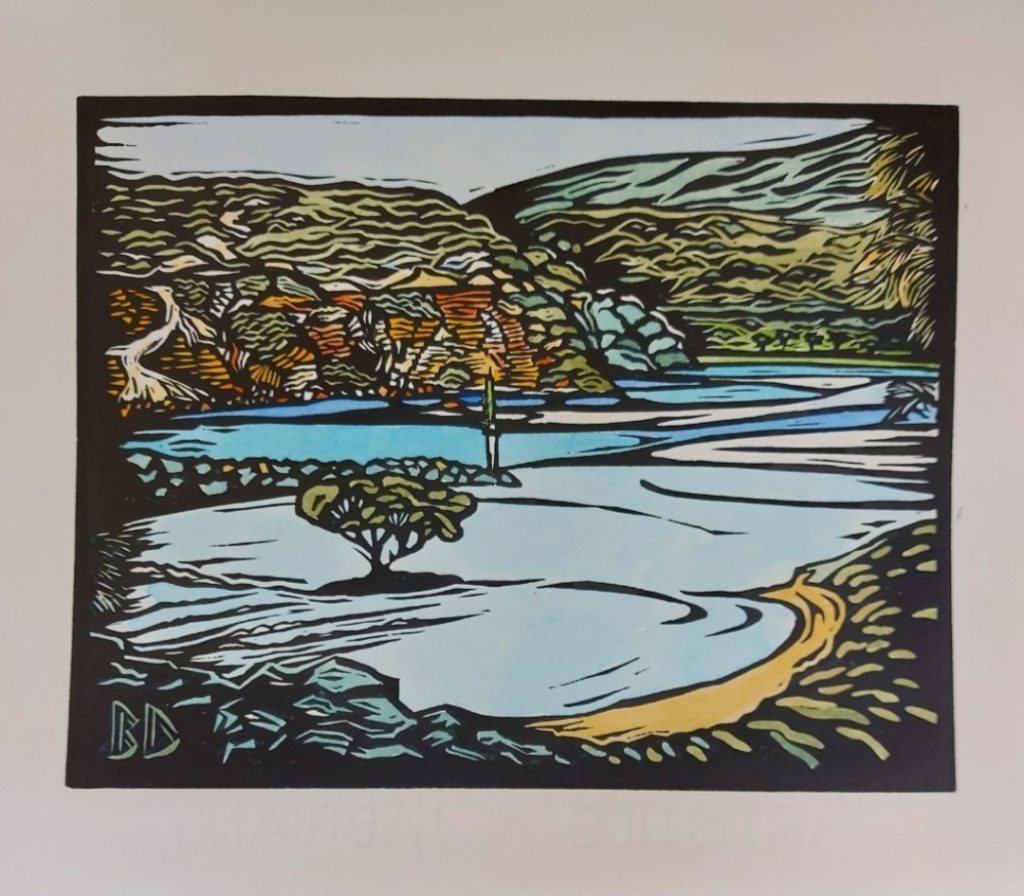
Wooli Wooli
The focus of the Wooli Wooli print can be found in the quiet and secreted corner of apple green verge on the opposite side of the river where a spur of foliage reaches down to the waters edge. More to the fore and more spectacular is the high escarpment with the wild and noisy coloured sands which usually demand all the attention but I get the feeling that this quiet and inaccessible corner area was the place of ancient habitation and murmurings.
Contact:
Brian Davidson
New South Wales, Australia
brianbingdavidson@gmail.com
Insta: Brian Davidson Art
Deborah Blakeley, Melbourne, Australia
Interview by Deborah Blakeley, November 2023
Think a colleague or friend could benefit from this interview?
Knowledge is one of the biggest assets in any business. So why not forward this on to your friends and colleagues so they too can start taking advantage of the insightful information the artist has given?
Other artists you may be interested in:


